Less than 150 metres from South Pier is Blackpool Pleasure Beach, Britain’s ‘most visited tourist attraction’. It began as a small fairground among the sand hills, in 1896. The Velvet Coaster was one of the exciting new rides introduced in the early 1900s. Its open carriages, with velvet seats, climbed a white wooden structure before sweeping down ‘humps’ and around ‘curves’ on two circuits of the track. The Velvet Coaster was rebuilt, in 1933, and was known simply as Roller Coaster, until 2010. It is now named Nickleodeon Streak.
A photograph and text about the history of Blackpool.
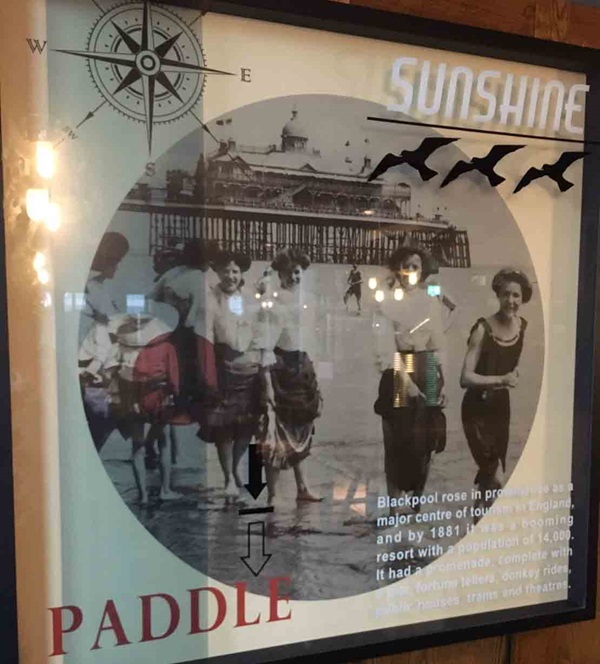
The text reads: Blackpool rose in prominence as a major centre of tourism in England, and by 1881 it was a booming resort with a population of 14,000. It had a promenade, complete with a pier, fortune tellers, donkey rides, public houses, trams and theatres.
An illustration and text about Blackpool rock.
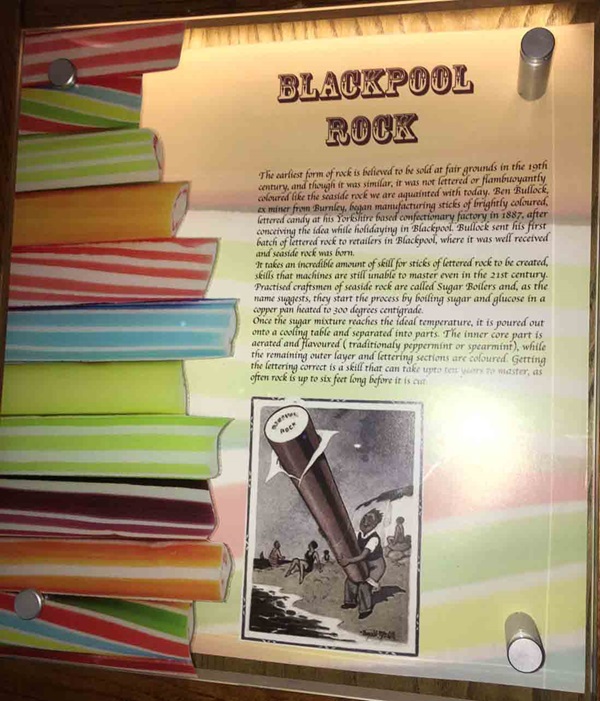
The text reads: The earliest form of rock is believed to be sold at fair grounds in the 19th century, and though it was similar, it was not lettered or flamboyantly coloured like the seaside rock we are acquainted with today. Ben Bullock, ex miner from Burnley, began manufacturing sticks of brightly coloured, lettered candy at his Yorkshire based confectionary factory in 1887, after conceiving the idea while holidaying in Blackpool. Bullock sent his first batch of lettered rock to retailers in Blackpool, where it was well received and seaside rock was born.
It takes an incredible amount of skill for sticks of lettered rock to be created, skills that machines are still unable to master even in the 21st century. Practised craftsmen of seaside rock are called sugar boilers and, as the name suggests, they start the process by boiling sugar and glucose in a copper pan heated to 300 degrees centigrade.
Once the sugar mixture reaches the ideal temperature, it is poured out onto a cooling table and separated into parts. The inner core part is aerated and flavoured (traditionally peppermint or spearmint), while the remaining outer layer and lettering sections are coloured. Getting the lettering correct is a skill that can take up to ten years to master, as often rock is up to six feet long before it is cut.
Photographs, illustrations and text about the design of The Velvet Coaster.
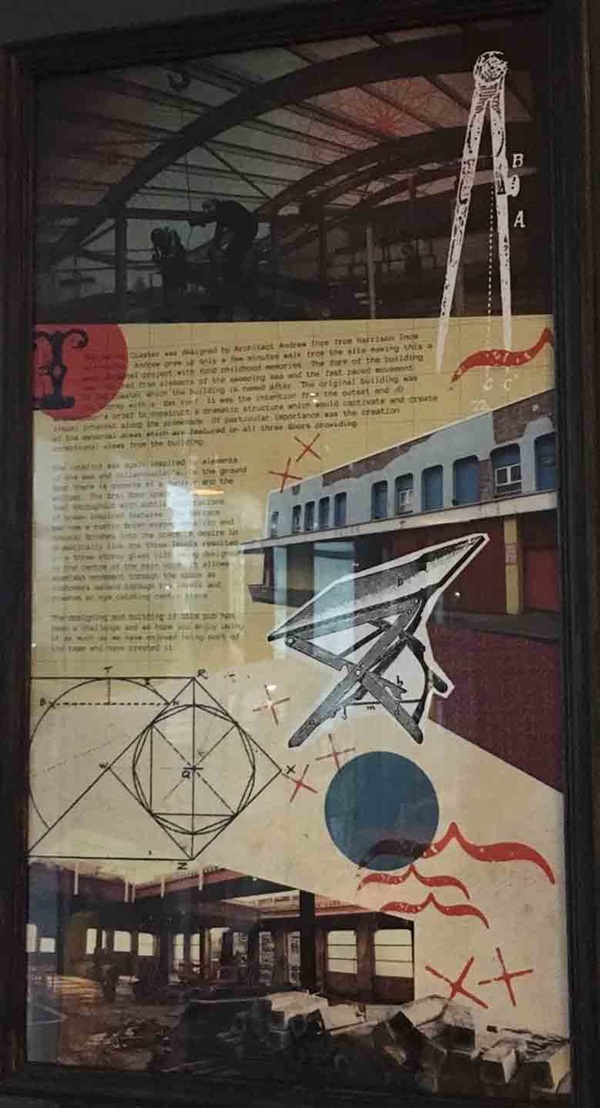
The text reads: The Velvet Coaster was designed by architect Andrew Ince from Harrison Ince Architects. Andrew grew up only a few minutes’ walk from the site, making this a very personal project with fond childhood memories. The form of the building was inspired from elements of the sweeping sea and the fast paced movement of the coaster which the building is named after. The original building was two storey with a flat roof. It was the intention from the outset and J D Wetherspoon’s brief to construct a dramatic structure which would captivate and create visual interest along the promenade. Of particular importance was the creation of the external areas which are featured on all three floors providing exceptional views from the building.
The interior was again inspired by elements of the sea and rollercoaster’s. On the ground floor there are aspects of a funfair and the waltzer. The first floor space has a warm feel throughout with subtle inspirations of ocean inspired features. The terrace bar has a rustic finish mixing metallic and natural finishes into one space. A desire to dramatically link the three levels resulted in a three storey glass lift being designed in the centre of the main void. It allows seamless movement through the space as customers ascend through the levels and creates an eye catching centre piece.
The designing and building of this pub has been a challenge and we hope you enjoy using it as much as we have enjoyed being part of the team who have created it.
Photographs and text about Blackpool’s lido.
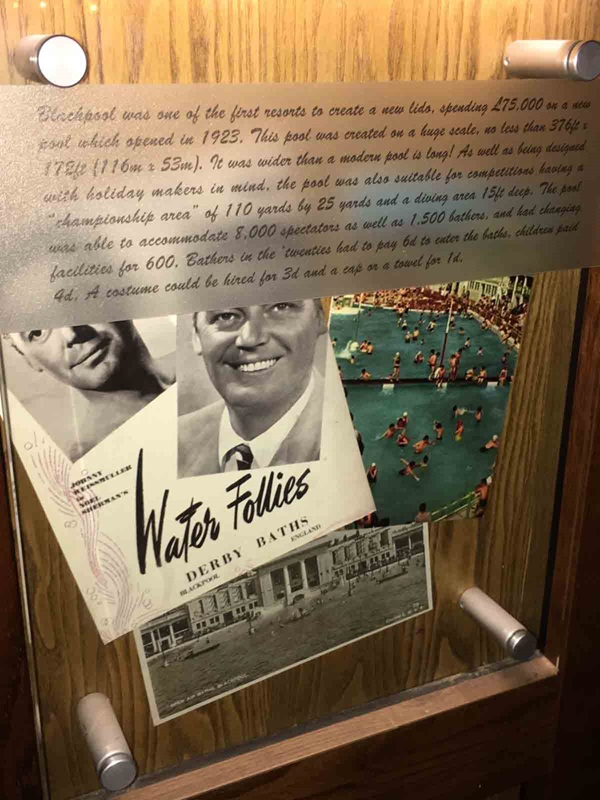
The text reads: Blackpool was one of the first resorts to create a new lido, spending £75,000 on a new pool which opened in 1923. This pool was created on a huge scale, no less than 376ft x 172ft (116m x 53m). It was wider than a modern pool is long! As well as being designed with holiday makers in mind, the pool was also suitable for competitions having a ‘championship area’ of 110 yards by 25 yards and a diving area 15ft deep. The pool was able to accommodate 8,000 spectators as well as 1,500 bathers, and had changing facilities for 600. Bathers in the twenties had to pay 6d to enter the baths, children paid 4d. A costume could be hired for 3d and a cap or a towel for 1d.
Text about the history of wrestling in the area.
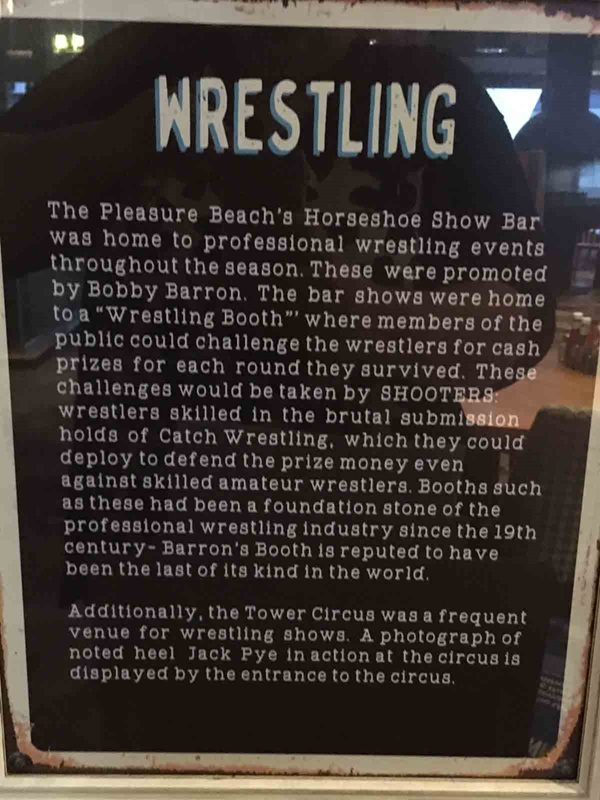
The text reads: The Pleasure Beach’s Horseshoe Show Bar was home to professional wrestling events throughout the season. These were promoted by Bobby Barron. The bar shows were home to a ‘Wrestling Booth’ where members of the public could challenge the wrestlers for cash prizes for each round they survived. These challenges would be taken by SHOOTERS: wrestlers skilled in the brutal submission holds of Catch Wrestling, which they could deploy to defend the prize money even against skilled amateur wrestlers. Booths such as these had been a foundation stone of the professional wrestling industry since the 19th century - Barron’s Booth is reputed to have been the last of its kind in the world.
Additionally, the Tower Circus was a frequent venue for wrestling shows. A photograph of noted heel Jack Pye in action at the circus is displayed by the entrance to the circus.
A painting of the Winter Gardens.
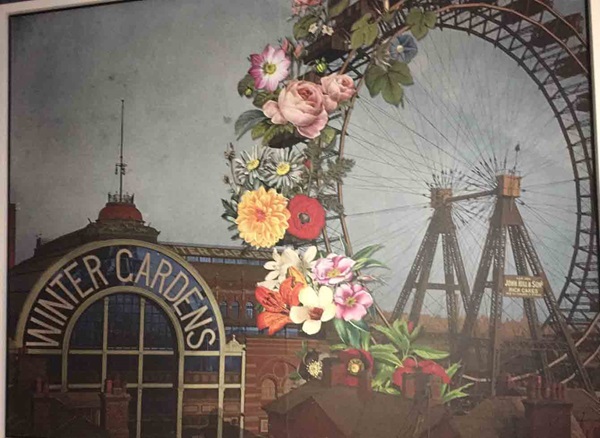
A wicker sculpture inspired by Blackpool’s classic entertainers.
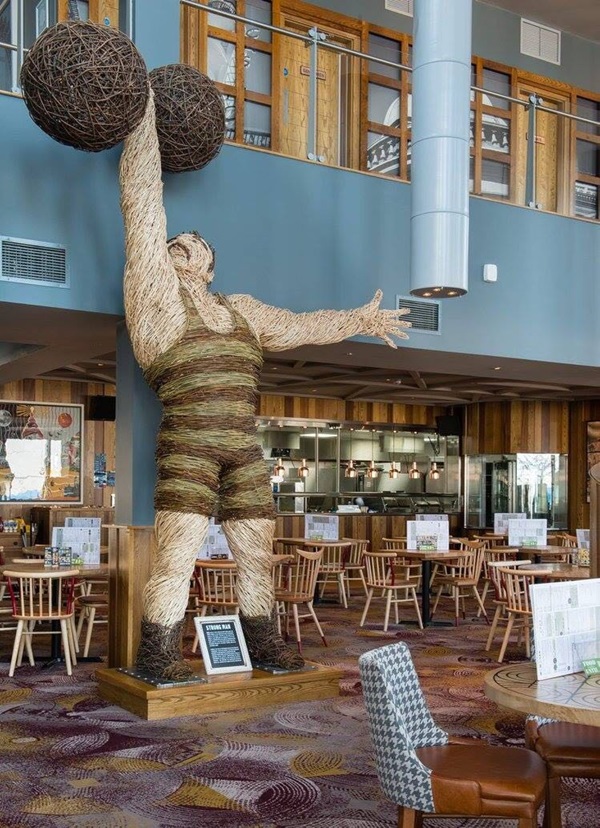
A print entitled Blackpool, by Robin Ross.
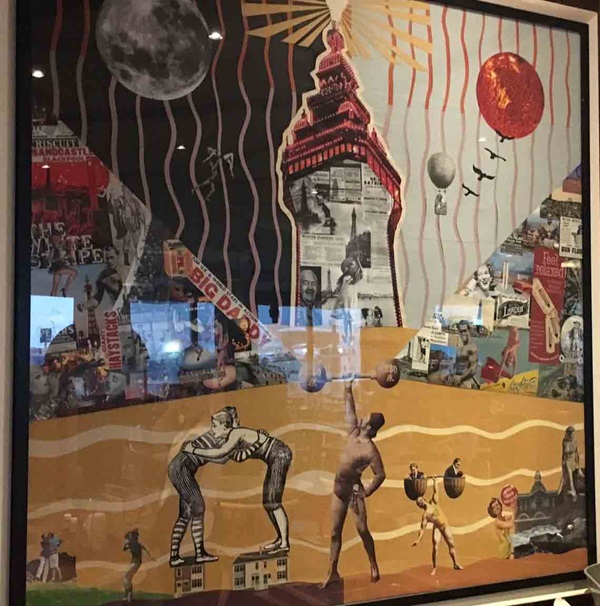
Robin Ross is an artist based in central Blackpool in the Old Rock Factory. He designs for Blackpool Illuminations and created the international urban art event in Blackpool called Sand, Sea & Spray, where up to 40 artists from all over the world gathered to paint live in Blackpool.
He had a London show last September in Notting Hill, and has work in a gallery in Austin, Texas. Robin has been invited to return to Havana by the International Head of Art for Cuba, to print with Cuban artists.
Earlier in Robin’s career he worked as a promoter of musical events and then found himself DJing at London’s Rock Garden in Covent Garden. This lead him to a radio career, which began on a pirate station called Merseyland Alternative Radio. He was then offered a gig on Radio Caroline by Johnnie Walker, which was run from a big boat in the North Sea with a 12 million audience across Europe. This he says changed his life. After a very colourful year broadcasting from a boat he joined Red Rose Radio in Preston and was made head of music. Then he was off to Radio Radio the UKs first satellite radio station, plus his own production company. Life was incredibly busy for Robin. The interviews kept coming and travelling the globe with some great clients including Sir Paul McCartney, Sir Elton John, Sir Cliff Richard, Tom Petty, Genesis, Take That, Joe Cocker, Cher, Tina Turner… and as a result 35 silver, gold and platinum discs, of which he is very proud. Other stations came knocking, Marcher Sound & Jazz FM.
Ray Lowry designed the iconic London Calling album sleeve for The Clash, combining the legendary photograph taken by Penny Smith, with the Pink and Green colours taken from an Elvis Presley LP sleeve. It worked and became one of the great record sleeves of the time. Ray Lowry passed away in 2008 and in 2011.
Robin was approached by the Lowry foundation to make a series of limited edition hand pulled screen prints from Ray’s original sketch books from his time on the road in America and beyond, with The Clash. He jumped at the chance! Lowry was described by Joe Strummer as ‘The Clash’s War Artist’.
“I was the resident DJ, at The Rock Garden in Covent Garden at a time when the 100 Club began to book bands other than jazz and saw the Roxy develop as a venue in the 70s, to work on these images was a project you only get offered once.
These images have rarely been seen and not before printed using silk screen, which is the preferred method for printing posters, fanzines for so many of the bands of the hitherto punk era.
Three years in the planning, over 250 prints, reams of paper and litres of ink…’’
Joe Strummer and the Mascelleros played Blackpool Winter Gardens on 13 November 2002 one of his final UK dates before his passing in December 2002.
The Rebellion Festival held in Blackpool during August is huge. Punks and bands from all over the world travel to Blackpool for the event. The local constabulary love the event because there is never any trouble and the fans come only for the music.
A sculpture entitled The Wave.

The text reads: The inspiration for this sculpture has come from Blackpool’s coasted location along Fylde’s rugged coastline. The artist has made this sculpture from lengths of steel that have been put under a power hammer. They have been heated to a point where the steel is yellow hot and then bent into shape in a press. It has then been polished to give it a silver highlighted finish.
External photograph of the building – main entrance.
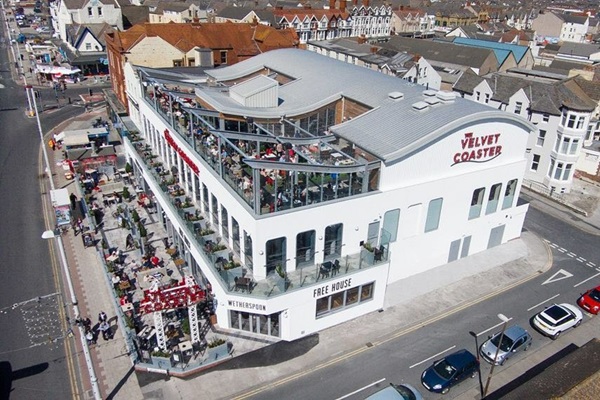
If you have information on the history of this pub, then we’d like you to share it with us. Please e-mail all information to: pubhistories@jdwetherspoon.co.uk